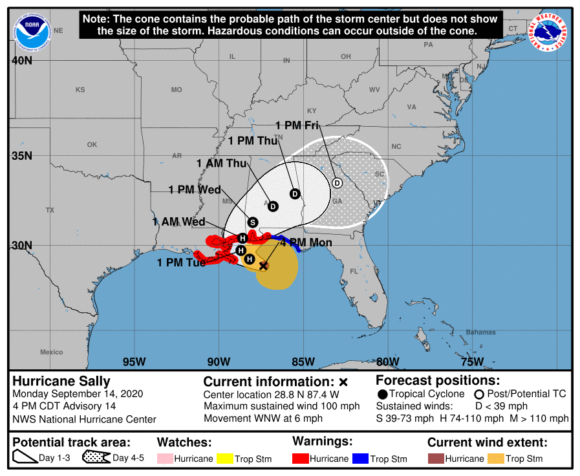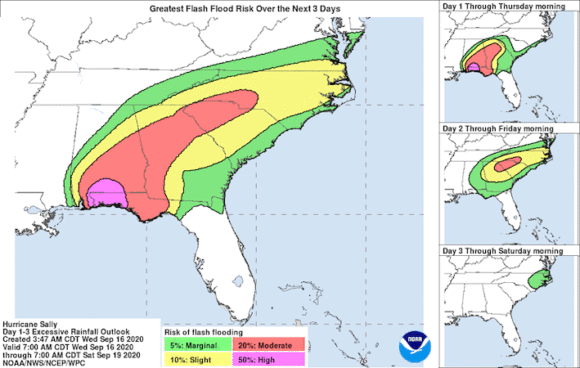Hurricane Sally made landfall on Alabama’s Gulf Coast on Wednesday morning as a Category Two hurricane, spreading strong winds inland across southeastern Alabama and western Florida.
Upon landfall, winds were clocked at 105 miles per hour (165 km per hour), able to cause extensive damage, according to the five-step Saffir-Simpson scale. The hurricane also poses the risk of “catastrophic and life-threatening” flooding along portions of the north-central Gulf Coast, the National Hurricane Center said in an advisory around 6 a.m. CDT (1100 GMT).
The NHC earlier said the hurricane could bring more than 2 feet (60 cm) of rain to some areas as it creeps inland.
Sally made landfall at Gulf Shores, Alabama, and was creeping toward the Alabama-Florida border at 3 mph (5 kph). Its winds and rains will stretch from Mississippi to the Florida Panhandle, the NHC said.
In Dauphin Island, Alabama, winds sustained 81 mph (130 kph), while in Pensacola, Florida, winds were at 61 mph (98 kph), NHC said.
In Mobile, Alabama, strong winds shook windows while trees and power lines swayed.
Officials across the South had called on residents of low-lying areas to shelter away from the winds and rain. But for some, Hurricane Sally’s slow approach brought a chance to relive childhood memories of storms past, and to witness the power of nature first-hand.
Thomas Harms braved the wind and rains on Tuesday to watch the waves crash into the Fairhope Municipal Pier, and reminisced about past storms. As a child, he went with his grandfather to see storms arrive, and he did the same on Tuesday for his son.
“It kind of takes a little bit of the fear out of it and also help you understand the dangers of it too,” said Harms. “I’ve been kind of passing that on to my son in doing the same thing.”
Others joined him on the pier to catch a glimpse of what was to come.
“We were at home saying ‘we’re bored’, so I was like ‘how ’bout we go to Fairhope and see how bad it is out there.’ As you see, it’s pretty bad,” said Warren Babb.

Damage from Sally is expected to reach $2 billion to $3 billion, said Chuck Watson of Enki Research, which tracks tropical storms and models the cost of their damage. That estimate could rise if the heaviest rainfall happens over land, Watson said.
Ports, schools and businesses were closed along the coast as Sally churned. As the storm track shifted east, ports along the Mississippi River were reopened to travel on Wednesday. But they were closed to vessel traffic from Biloxi, Mississippi, to Pascagoula, Florida.
Energy companies also shut more than a quarter of U.S. Gulf of Mexico offshore oil and gas production and some refiners halted or slowed operations.
(Reporting by Devika Krishna-Kumar in Mobile, Alabama, Catherine Koppel in Fairhope, Alabama, and Jennifer Hiller in Houston; additional reporting by Stephanie Kelly in New York; Editing by Christian Schmollinger and Chizu Nomiyama)
Topics Florida Catastrophe Natural Disasters Mississippi Alabama Hurricane
Was this article valuable?
Here are more articles you may enjoy.



 Chubb to Acquire MGA Healthy Paws From Aon
Chubb to Acquire MGA Healthy Paws From Aon  Trump’s Bond Insurer Tells Judge Shortfall Is ‘Inconceivable’
Trump’s Bond Insurer Tells Judge Shortfall Is ‘Inconceivable’  Marsh McLennan Agency to Buy Fisher Brown Bottrell for About $316M
Marsh McLennan Agency to Buy Fisher Brown Bottrell for About $316M  Uncertainty Keeps Prices Up; No Prior-Year Loss Development: Travelers
Uncertainty Keeps Prices Up; No Prior-Year Loss Development: Travelers 

